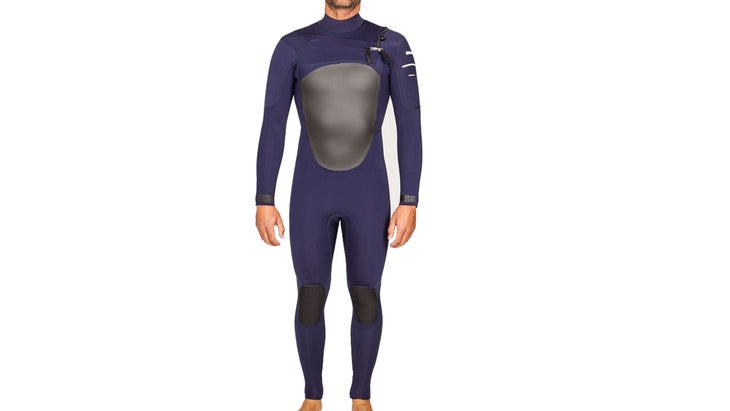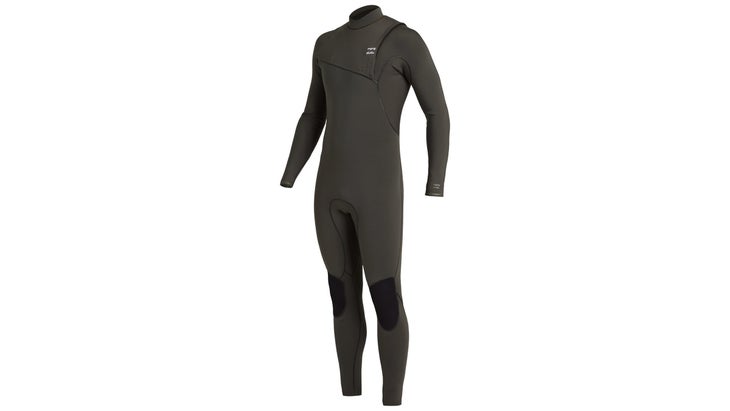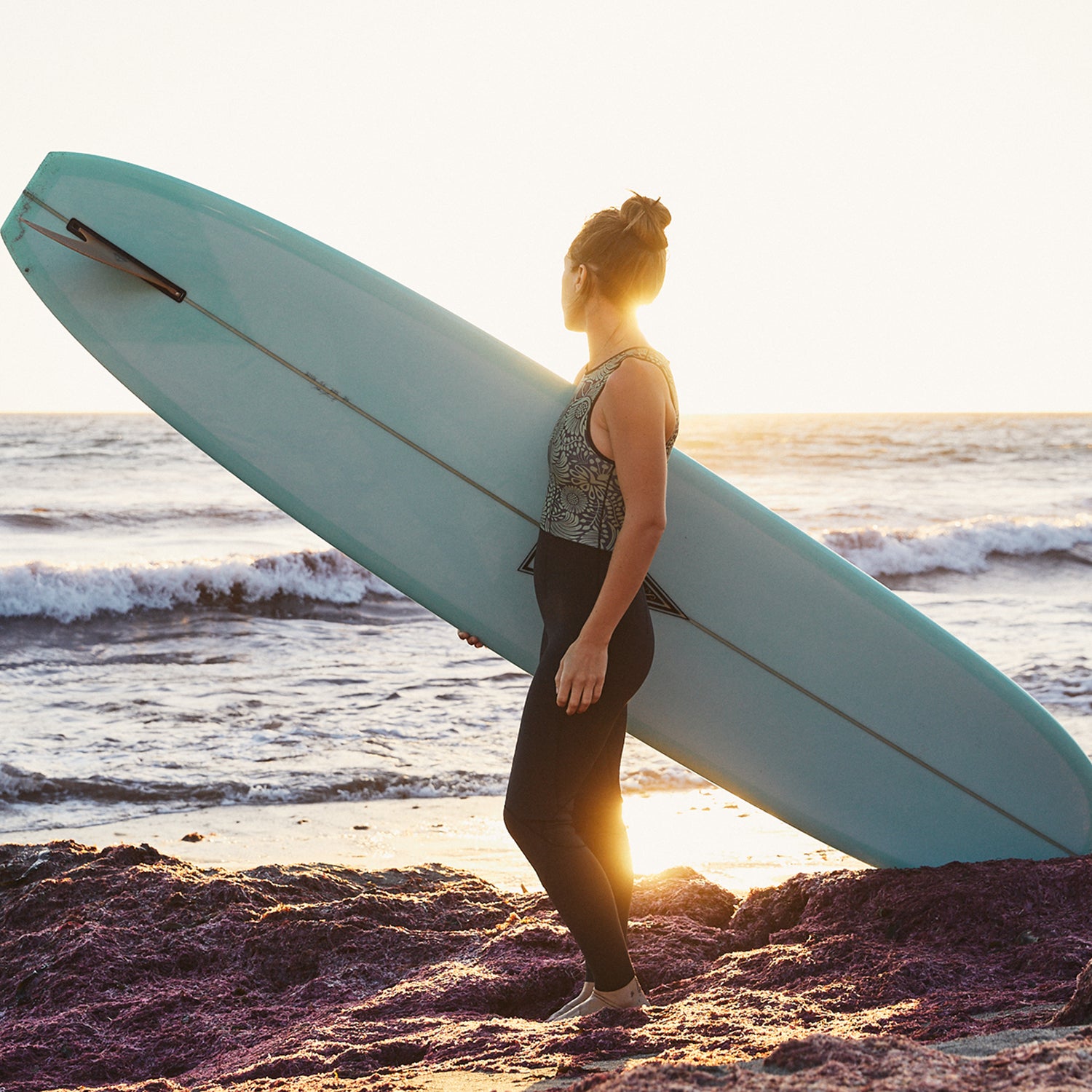In 2008, Patagonia made a surprising admission. Four years after the company’s first foray into wetsuit development, a member of its fabric-development team wrote on the company blog, “We’ve got a long way to go before anyone has a true ‘green’ wetsuit.”
At the time, Patagonia used a limestone-based neoprene for the foam, the core material of a wetsuit. Neoprene is typically derived from petroleum, and while limestone-derived neoprene eliminated the need to drill for or transport oil, it had to be processed at such a high temperature, the blog said, that its environmental impact was “equally significant.”
The post piqued the interest of Yulex CEO Jeff Martin and chief technology officer Jim Mitchell, both materials engineers in Solana Beach, California. With backgrounds in the medical-device and automotive industries, respectively, the men knew that neither petroleum nor limestone were necessary to make the rubber for a wetsuit, if one used natural rubber instead of a synthetic. They’d spent years cultivating the guayule plant from Mexico into a hypoallergenic natural rubber useful for making latex gloves.
Their hunch was that the guayule rubber could also be suitable for a closed-cell foam, like the kind needed for wetsuits. So Martin and Mitchell got to work on a prototype and asked Patagonia for a meeting. When they drove to Ventura to meet with the Patagonia surf team, they brought with them one piece of newly developed natural Yulex rubber foam, no bigger than an iPhone.
In 2013, Patagonia became the first company to release a surf wetsuit made with natural rubber. Martin and Mitchell began making Yulex with Forest Stewardship Council–certified Hevea brasiliensis, or the Brazilian rubber tree—a renewable, sustainable resource that can produce sap many times over and sequesters and average of 36.7 tons of CO2 per year.
Once any of these rubber sources reach the manufacturing facility, the steps to turn them into foam sheets are exactly the same—they require additives and a lot of heat energy.
But the environmentally friendly material still counts for a lot. For every kilogram of Yulex material created by tapping a rubber tree, processing that sap and turning it into rubber chips ready to be shipped to the manufacturer to create foam sheets, Mitchell estimates that between 7.1 to 9.6 grams of CO2 are emitted into the atmosphere. In comparison, creating the same rubber from petroleum results in CO2 emissions of about 182,000 to 196,000 grams, according to Mitchell’s calculations. For limestone, he estimates that the number could be as much as twice that, because of the heat required to process the rock.
When Patagonia first started using Yulex in 2013, it cost substantially more than sourcing rubber made from petroleum or limestone. At the behest of then CEO Rose Marcario, Patagonia absorbed the margin decrease rather than passing it on to customers, and it encouraged other companies to adopt the technology as well. “She told me they were going to stick their necks out and suck up the high initial prices because it was the right thing to do for the industry,” recalls Martin, “and that as the industry grows and the volume increases, the price will come down.”
Widespread adoption by the surf industry, however, was slow. The price deterred some brands, and so did fear of compromising performance. It took a lot of trial and error to figure out how to process Yulex to create a foam that stretched and performed the way consumers expected it to.
But that’s changing. As the price of Yulex continues to come down, and as performance increases and consumers increasingly demand more meaningful consideration of the environment from brands, more companies are offering Yulex suits—enough, in fact, to put together a roundup of men’s and women’s Yulex spring suits for warm-water surfing.
We tested suits from the five brands currently offering Yulex surf products in the U.S. All of these offerings have their own advantages in terms of warmth, comfort and fit, meaning that for surfers searching for a wetsuit with less environmental impact, the question is no longer whether there is a good option out there, but which one they like best.
Seea Sydney Two-Millimeter Yulex Long Jane ($250; XS to XL)

The two-millimeter Sydney has been a favorite since its release in 2018, and this year the Long Jane is available in all black as well as a floral print. It has great stretch—enough that I went down one size in the new model to keep the compression of a tight suit. And in the smaller size, I experienced none of the chafing that’s common with sleeveless suits, even on the first day wearing it.
The knees are extra padded for increased comfort and durability when paddling, while dart seams along the waist on both the front and back give it a flattering, tapered-waist look. But my favorite feature by far is the snap–Velcro flap on the right shoulder, making it easy to get on and off, especially for anyone with an injured shoulder.
I usually avoid patterned wetsuits, preferring a more subtle style, but the new floral design is beautiful and I received multiple compliments on the suit my first time in the water—in fact, two of the women who noticed it ended up buying the suit after seeing mine.
Seea wetsuits go beyond Yulex to achieve sustainability: They are lined with recycled polyester-spandex and laminated with solvent-free glues. The company will repair your suit for free, but my original Sydney Long Jane still shows no signs of wear and tear.
Seea also offers a Yulex jacket, spring suit, and surf cap.
Ansea Yulex One-Piece ($180; XS to XL)

The two-millimeter Ansea Yulex One-Piece is perfect for hot summer days when you only need a little bit of foam to protect from the breeze or some extra padding on the ribs for paddling. Its distinctive feature is an extra-long back zipper that runs all the way to the base of the spine, which founder Abigail Lorick says was designed to make it easy to take the suit on and off, especially for women with wider hips.
The moderate-coverage bottom makes this suit sexy, while a high neckline keeps it classy. The one-piece fits true to size and has great stretch. Like the Seea Long Jane, it caused zero chafing, even on the first wear. The simple black suit is great for minimalists who prioritize performance but still seek some subtle style.
In addition, it’s lined with a recycled jersey and bonded with water-based glues, while the heavy-duty zipper and stitching makes me think this suit will last multiple seasons with no issues.
Ansea also offers a Yulex jacket and Yulex Jane long-sleeved spring suit.
Patagonia Men’s R1 Yulex Long-Sleeved Top ($129; S to XXL)

Our male field reviewer tried the Men’s R1 Yulex Long-Sleeved Top while out in 66-degree water during a sunset session, when the air temperature was about 65 degrees. It kept him warm in the cool water, and the medium size fit his five-foot-nine, 155-pound frame perfectly. Even on the first wear, there was no underarm or neckline chafing.
Our tester also found it to be pleasantly stretchy and comparable to the conventional neoprene top he typically wears. The cinch cord on the side of the waist allowed for a tight fit that prevented any water flushing. In larger surf, you can tie the board-short loop into the laces of your trunks to make sure the top doesn’t come off on a wipeout.
The R1 top is 1.5 millimeters thick, offering just enough wind protection on a summer evening, but if the air has a chill to it, opt for the R1 Lite Yulex Front-Zip Long-Sleeved Spring Suit, which ratchets up the thickness to two millimeters and affords some leg coverage.
Patagonia has by far the most extensive offering of Yulex suits for men and women, ranging from accessories like hoods and gloves to hooded 6.5-millimeter full suits.
Finisterre Men’s Nieuwland 3e Yulex Wetsuit ($399; S to XL)

Depending on where you live, summer means different things. In Encinitas, California, where we tested these suits, it often means 70-degree water and 85-degree air temperature. But in places like Canada, Maine, and Oregon, the water may never get above 50 degrees in June. Which is why we included the Finisterre Men’s Nieuwland 3e Yulex three-millimeter wetsuit, designed by the UK-based brand.
Finisterre just released its first line of Yulex suits, including men’s and women’s versions of the Nieuwland. We could tell it was the company’s first foray in some aspects of the suit. Our tester found this suit more difficult to get in and out of than average front-zip winter suits, because it was stiffer than the other Yulex offerings he tested and because the opening was smaller. These traits are also reflected in the online reviews for the suit on Finisterre’s website. The brand does note in the specs that the suit will loosen after 10 to 15 wears, but that’s a lot of stiff paddles and wetsuit wrestling matches in the parking lot before achieving more flexibility.
That said, there’s plenty to like. Our tester noted that this 3/2 suit felt very warm, toastier than a typical 4/3, and with less thickness. The smooth chest and back panels protect against strong winds, and heavy-duty taped seams and tension wristbands keep the suit bone-dry with zero leaks. A robust zipper combined with a unique front-panel design kept flushing to a bare minimum. All of these features contribute to what is a heavier but warmer suit.
Finesterre also offers a women’s Yulex two-millimeter swimsuit and two-millimeter short.
Billabong 3/2 Natural Furnace Zipperless Full Wetsuit ($450; S to XL)

This full suit from Billabong’s Natural Furnace line is by far the softest and stretchiest Yulex (and maybe even non-Yulex) suit on the market right now. It’s a distinction that global director of wetsuits Scott Boot credits to years of working with their manufacturer to create the ideal lining.
The outer is a 100 percent recycled-fiber jersey infused with Ciclo, an additive that allows synthetic fibers to biodegrade like natural fibers, which helps minimize microfiber plastic pollution. The interior graphene lining is also made from 100 percent recycled fibers, and all lamination is done with water-based adhesives.
Our tester actually wore a prototype short-john version of this suit. The soft material inside and out meant this suit was immediately comfortable, especially on the neck, with no chafing or rubbing. Thanks to its remarkable stretchiness, it will likely fit surfers of varying body types and allows for “zero restriction of body movement in any direction,” our reviewer said. The only downside to the flex of the suit was that the wrist openings seemed to have too much give, which led to some flushing while paddling.
All of the Natural Furnace suits feature a zipperless entry system, meant to reduce weight and the amount of material used to make the suit. This system has both pros and cons: on the one hand, a snug fit meant our tester experienced zero flushing through the neck, but he found it difficult to get in and out of the suit.
During an early-morning session with light wind, with the air and water temperatures both about 65 degrees, this suit kept our tester warm for more than an hour.
Overall, the Natural Furnace is unbelievably soft and flexible. If you can get used to the zipperless entry, and size appropriately to account for the extra stretch, you’re in for many comfortable sessions.
The Natural Furnace line currently consists of 4/3 and 3/2 full suits, and a one-millimeter long-sleeved top. The spring suit reviewed here will be available in January 2022. The line will include women’s wetsuits by September 1, 2021.

